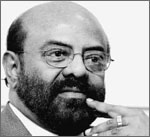Shiv Nadar was 22 when he saw his first city. Now, as chairman and CEO of HCL Technologies, he is worth some $3 billion, according to a Forbes magazine estimate last year. In the second of a two-part interview with Knowledge at Wharton and Ravi Aron, a senior fellow at Wharton’s Mack Center for Technological Innovation, Nadar discusses the challenges confronting Indian manufacturing and potential synergies between Indian and Chinese business.
Aron: Infosys, Wipro, Satyam and TCS are the big four Indian software firms. How do you distinguish HCL from them?
Nadar: HCL is drastically different. If you look at the leading Indian IT companies, Cognizant is not active in business process outsourcing (BPO), and neither is Satyam. Wipro is strong in BPO, but for TCS, compared to its software business, BPO is very small. Even Infosys’ BPO operations are minor in relation to the rest of its business. But if you look to the future, BPO will outpace software.
Globally, as work is re-distributed to various countries, infrastructure will have to be managed remotely. We created that industry. The Gartner Group has acknowledged that HCL is a world leader in that business. We run the National Stock Exchange remotely; that represents the third-largest number of trades in the world. We run about half a million servers remotely.
Another factor that makes HCL different is R&D outsourcing. You can do that in at least two ways. One is to take a design for an operating system and say, “Let’s maintain that.” Another is to take an operating system, and in addition to maintaining it, to develop it further by adding new features and making them available to the end users. Under the second model, we might go to a client and develop progressively sophisticated products, against whose sales HCL receives a royalty. We may even hold the patent jointly, so that no one else can use those products. So, now HCL is at the edge of R&D where we create patent-yielding products for others. For example, we have worked actively with Boeing on the 787 Dreamliner. This is different than what other Indian IT companies are doing.
Aron: I have some questions there. Let’s take R&D for a moment. About 65% of your business comes from software product engineering and some 35% from hardware and mechanical engineering. Did the 65% grow and exceed the hardware and mechanical engineering in the past two or three years?
Nadar: It’s the other way around. Mechanical and hardware engineering have started coming into play now. Our entire aerospace initiative is a mechanical engineering project. We also are doing interesting biomedical work — it is a hardware engineering project. There is a product we are building…do you know about the insulin pump?
Aron: No.
Nadar: Let me tell you about that. Some diabetics need insulin every day, and as a rule it is injected into the bloodstream. The amount of insulin that can be injected into the bloodstream is close to 100 times higher than if it could be done through the nervous system. But to inject insulin through the nervous system, you would have to do it through the spine, which is not only excruciatingly painful but almost impossible to do on a daily basis, because before the injection you have to measure a series of parameters.
The system we have built begins by measuring the parameters. This comes from first making the chip that measures how much insulin needs to be injected. It is a very small amount. You plant a pump to release the insulin and leave it inside the body.
Aron: So you do real-time biometrics and then the pump responds…
Nadar: Oh yes. And it can be kept inside the body for seven years. That’s why I said the kind of engineering we are doing and technology with which we are working is seriously advanced. We are working on this project with a collaborative partner.
Biomedical engineering is an evolving field.
Aron: Before we come back to collaboration, I wanted to ask about HCL’s approach to BPO. About 26% of your revenues come from technical support, 37% from customer contact services, and finance and accounting account for about 20%. One issue that Indian companies are facing — which Knowledge at Wharton had written about four years ago — is that the low-margin, high-volume inbound call voice-based business is highly nomadic, though it generates revenues per employee of between $8,800 to $11,400. Today it’s in India, tomorrow it could move to Vietnam, Morocco, Mauritius, or Cambodia.
Nadar: Wherever it’s 50 cents cheaper.
Aron: Right. Companies move for a 50-cent advantage. Was there a deliberate decision on your part not to touch this business?
Nadar: No, we ventured into it because we wanted to wet our feet. We wanted to see for ourselves whether BPO was interesting. We could not just say we had decided to stay out of it because it’s too large. We saw a migration of work taking place, and it would have been too early to stay out of the migration.
Aron: Is BPO slated to become one of your major business lines?
Nadar: If you want to know what will become not just one of our biggest business lines but also among the most profitable, that is our technology business. It will provide the maximum yield to shareholders. That is the kind of work we are doing with companies like Deutsche Bank and Boeing. That won’t go away for 50 cents less.
To do such work, HCL has to become a partner, a strategic partner, to our clients. We can’t remain just a vendor. Frankly, out of 500 organizations for whom we work, we are bound to be vendors to some 450. If we don’t work for them, somebody else will. But to the other 50, we make a real difference. Those 50 firms cannot do without us because we are their strategic partners. That’s not a very comfortable statement, but it is true — they cannot do without us. Does it mean that they are prisoners of HCL? They are not prisoners, but they have stopped doing the work that we do. There’s a huge amount of trust. Annual contracts are no longer necessary or even relevant.
Knowledge at Wharton: How did the transition from vendor to strategic partner happen? Is this something you consciously sought, or did it evolve?
Nadar: We consciously worked for it. Over the years HCL has turned down lots of business. We’ve just walked away, and we have learned to say, “No.”
Today, when I look at software business, it’s much simpler than it was in the early days when we were building HCL. Saying “no” had to come to us. It’s a matter of vital importance. You have to say “no” if the machine is not going to do the job. Otherwise, for that one customer you could lose ten. And, to be perfectly frank, there was a period when we said “yes” to just too many things. In the past 30 years, at least two years had to be written off because of that.
Aron: Did you consciously train your managers to look at customer size and intent and turn away piecemeal jobs that lacked a strategic component?
Nadar: Our managers needed re-orientation because most of us are very bad at saying “no.” When Laxmi [the goddess of wealth] comes to your doorstep, it is difficult to close the door and say no to new business. We had a conversation with a client who needed help with high-precision manufacturing for aircraft class aluminum. We initially tried to turn them down because we did not know metallurgy, but it turned out to be enormously profitable. Unknown business does not scare us because that’s what we’ve done all our lives. But if a business opportunity does not use our strengths, we have to say no.
Aron: Did you train your managers to be partners, i.e., treat HCL’s business of Boeing as an extension of Boeing itself? How did you go about that?
Nadar: That is very difficult. Most people make poor partners because their mental script has a defect. They believe focus means looking after their own interests. It’s a script error. Someone at Wharton should find out how to correct the script.
Aron: But HCL has a long history of partnering with companies like Hewlett-Packard, Boeing and Deutsche Bank. You have chosen organizational forms that other Indian companies did not opt for until the late 1990s. Your partnerships involve redistribution, contract engineering, original engineering, patent-yielding products, and so on. This is very different from partnerships as Indian companies have traditionally done them. Where did that come from?
Nadar: I suppose the fact that HCL was a partnership of its founders may have taught us how to work with others. That’s all I can think of.
Knowledge at Wharton: A lot of partnerships and alliances end up destroying value. How do you manage partnerships to create value instead of destroying it?
Nadar: Toshiba has been our partner for 25 years. The highest market share they have anywhere in the world is 2%; in India it is 27%, which is higher than Xerox. (Xerox is at 24%; this is possibly the only country in which Xerox is behind anybody.) We decided to do business in this area together. They have notebooks, we distribute them. At one time, Toshiba was the leader in mobile computing, but unfortunately, they fell by the wayside. We were patient with them. I suppose it’s got to do with our mental makeup. We may be bad businessmen, but we don’t look at leaving our partners as a possibility. We try to stay with them, unless the partnership has an end-date written into the contract.
Aron: I have a question that will take us into the Indian policy environment and its impact on HCL. I once had an interesting conversation with a well-known policymaker and he said, “Chinese manufacturing succeeds because of China, while Indian entrepreneurs succeed in spite of India.” What do you think?
Nadar: The classic experience I have is based on the fact that our company was involved in manufacturing. We would get so tired sometimes and wonder if we should stop manufacturing, but we persisted because people wanted to buy our products. Manufacturing in that environment, year in and year out, was extraordinarily difficult. For example, we needed a license that allowed us to import 1,753,348 integrated circuits, and we were supposed to keep count and give the reconciliation to the government every year. It was an impossible, very nasty, very hostile set of conditions. It had to give way; it had to break. This still exists in some places, this control-orientation, and it creates suicidal conditions for many industries. If the government lets it go, it will be a different world.
Aron: You think manufacturing employment and activity in India would pick up significantly if regulations were relaxed further?
Nadar: That is correct. If you take any sphere of manufacturing, the input controls are crippling. India is possibly the only country in the world that taxes manufacturing. Is there any other country where it is taxed? Manufacturing is an activity that creates jobs, so why should it be taxed? If you were to go back to the Indian Salt and Excise Act of 1928 and 1932 — I have read it — it imposed taxes because the colonial British government wanted to discourage local manufacturers. That is how that taxation got started. But today, at a time when the Indian government wants to encourage economic activity, why should such taxes have any role? It does not make any sense. Why should India still behave as if it were a colony?
Moreover, there is a cascading impact on materials, which are taxed at so many points. If you were to take a paper cup, everything that goes into it — the paper, the pulp, the wood shavings — is taxed. The way the VAT (value-added tax) system is set up, it’s like taxing your own prosperity.
Aron: Now let us turn to the infrastructure. In electricity, for example, it is estimated that $8 billion to $10 billion a year needs to be spent to bridge India’s power deficit. Isn’t the infrastructure adding an invisible cost to Indian manufacturers?
Nadar: Ah yes, it is terrible. We require $200 billion to cover India’s electricity needs in the next five years. We don’t have the kind of project management skills needed to build these power projects, so many of them will have to be constructed on a build-operate-transfer basis. I suppose they are on their way. That is my hope.
Aron: How about feeder industries like surface transport, electricity, and airports? Three things are needed here: Allow foreign investment, allow private production, and take the controlling hand off distribution. Do you think any of this will happen in the near future?
Nadar: When I talk to senior ministers privately, they all want to do it. This is true of the present government and the previous government. They want to do it, they know what needs to be done, and everyone knows the steps.
Knowledge at Wharton: What’s holding them back?
Nadar: We need more political cohesion. I suppose that still eludes us.
Aron: Let me ask about entrepreneurship in India. You have been an entrepreneur for more than three decades. Is there a change in young people, the way they think and the things they want to do?
Nadar: I don’t know, but I hope so. If you were to ask me who will be the world’s wealthiest person in 2015, I would say I don’t know. Possibly Bill Gates may continue to be, but he may give away his wealth. It’s difficult to judge. If you ask about 2025, that too is very difficult to state. But if you were to ask about 2055, you can have a very definitive answer: That person isn’t born yet.
In the same way, today trade between Japan and China is possibly the largest in the world. But who will be the biggest trading partners in 2025? Already people say it will be India and China. Now, today Indian distribution companies are going very cheap, whereas there is a huge unused manufacturing capacity in China. I don’t know why young entrepreneurs don’t put these two pieces together. You don’t have to build a brand new operation, the parts already exist — and there are plenty of private equity guys around whose money is looking for a home. Some young entrepreneurs should just put these pieces together and put their career on hold for five years. I don’t know why business school students don’t do this, particularly those who come from India. They should go to China, match the parts, and when the market explodes, in five years they could take the company public and make a killing. Not enough people are contemplating this. To me it’s so clear it may not be visible only to a blind person. When someone brings China and India together it will be a big story, and one that’s worth a lot of money in a public company.
Knowledge at Wharton: When you look back on your career, what would you have done differently?
Nadar: I would have organized things differently. I have always run the company hands on. As the CEO of HCL Technologies, I was a hands-on CEO. For 18 years when I was CEO of HCL Infosystems, I was hands on. I could have taken my hands off the steering wheel a lot earlier and delegated more authority than I did. I did delegate authority, but I could have done more.
Aron: Let us go back to the beginning for a moment. You must have been one of the very few Tamilians who decided to go into business. You settled in New Delhi and went into the computer business. What was the cultural construct here?
Nadar: My father was a judge, so he was located in various places as his postings went around. I come from rural stock. I studied in Tamil, never in English. I got my PhD in engineering in Coimbatore [in southern India]. I first saw a city when I was 22. I went to work in Delhi at 23, and fell in love with my wife, who is a Punjabi and therefore completely different in terms of language and even racially different.
Knowledge at Wharton: HCL has just turned 30. So what’s in store for the next 30 years?
Nadar: Whatever life turns out to be, that is a challenge for the next leadership team. Our next leadership team has plenty of time to make an impact. I see a difference in their way of thinking. They are a lot more aggressive than I was.



